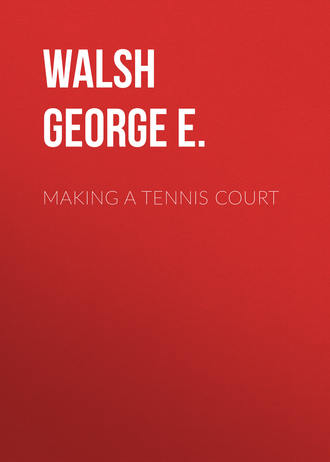 полная версия
полная версияMaking a Tennis Court
The construction of a grass court is simple when no attempt is made to drain it. The first thing to do is to lift the grass sod as carefully as possible and lay it aside for later use. The sod should be cut down as nearly to six inches depth as possible, and should be lifted in squares of fifteen to eighteen inches. Pile the sod carefully on one side and keep moist and partly protected from the hot sun. When the sod has all been removed spade up the soil to a depth of eighteen inches, removing all stones, roots, and obstructions. Rake over carefully and roll down to a level, watering frequently and filling in all depressions. When a perfect level has been obtained replace the grass sods.
These must be put down carefully so that the edges meet snugly. Open cracks and seams must be filled in with smaller pieces of sod. Roll, water, and level the surface until all is satisfactory. Fresh sods may have to be cut and placed wherever thin places appear during the first season. In the spring of the year fresh grass seed may be sown.
If the turf or grass is poor it will be better to omit sodding entirely and sow the surface with seed. It is better in such a case to make the grass court in the fall of the year. The winter storms will settle it thoroughly and reveal weak spots. In the middle of March rake up the surface, level, sow the seed, and roll carefully. It should be sowed twice from different directions, so that an even catch is obtained. Sowing can be made in the fall or spring. About five bushels of grass seed will be needed for the full-size court. Do not use clover seeds in the sowing, nor guano for fertilizers. When the grass is high enough to cut use the scythe or sickle first, and keep the lawn-mower for later cutting. Remove weeds as fast as they appear, uprooting them, or, if the roots persist, rub salt on them. When the grass is tall enough for regular cutting, use the mower at least once a week, and oftener in wet weather.
In many localities worms are very numerous and destructive to tennis courts. By working up to the surface they form little mounds and holes which permit water to trickle through and cause depressions. In regions where the worms are a great nuisance, a layer of finely sifted cinders is placed on the stone foundation of the dirt court or at the bottom of the excavation of a grass court. These cinders will keep the worms from working up, but if placed on the grass court the cinder layer must be at a depth of a foot or more below the surface, so as not to interfere with the grass roots.
One should remember that grass courts wear out more rapidly and require more care than those of dirt, especially when they are subjected to constant usage.
The cost of making tennis courts will vary considerably, as one may readily see. As much as $200 and $300 is sometimes paid for making tennis courts, but others are made at no greater cost than $25 where conditions are favorable and one is willing to do some of the work. The hardest courts to make are dirt ones laid on rocky foundations where blasting is necessary. Grass courts that are nearly level can sometimes be made by removing only a part of the sod and replacing it after digging out some of the under soil. This may cost only a few dollars.
SIZES AND MARKING
THE playing surface of a tennis court for singles is 27 × 78 feet, and for doubles 36 × 78 feet; but as a double court contains all the lines for singles it is usual to mark out for doubles at the beginning. Back of the outer line there must be a space of from 15 to 20 feet to the stop-nets, and at the sides there should be at least 6 feet, preferably 10 or 12 feet, beyond the line of the double court. This permits free access to the courts on either side of the net, and also allows room for players when volleying. This is the reason why a space of 60 × 120 is generally considered necessary for a good tennis site.
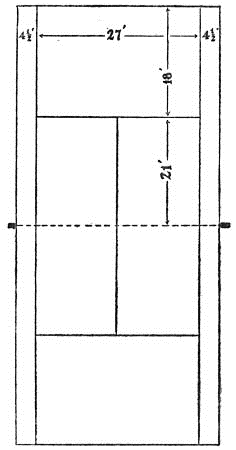
The standard dimensions for a double court are given. A convenient method of laying these dimensions out is given in the accompanying text
The marking of a court must be exact. First determine the position of your net in the middle of the site, and then lay out the single court. Place two pegs temporarily in the ground 27 feet apart and make a line there to represent the net. Then measure off two lengths of string—one 39 feet long, and the other 47 feet 5 inches. With these two lengths you can make your courts exactly right.
Lay the shorter length of string on the ground approximately at right angles to one of the net pegs; then start the longer string from the opposite peg and run it diagonally across until it reaches the end of the 39-foot string. At that point drive in a corner peg. You have a right-angled triangle that is absolutely exact. Repeat this operation to get the other corner, and then obtain the corners for the other side of the net in a similar way. With the corner pegs in place, proceed then to measure off from the net peg 21 feet on the 39-foot line. That point marks the end of the service line, and a straight line drawn across it will intersect in the middle the diagonal lines.
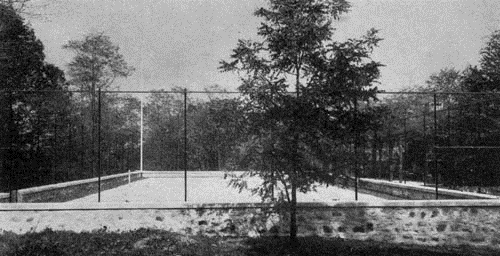
A space of 60 × 120 ft. is usually considered necessary for a good tennis court, and it is occasionally necessary to enclose this area with a low retaining wall of masonry
For the double courts prolong the net line 4 feet 6 inches, and join this to the points at the end to form alleys. The double courts are then finished except for the central line. This is obtained by measuring off the middle of the service lines and connecting them with a straight line through the center.
As there is quite a little bother in measuring off the courts, it is quite essential that the corner points be made permanent. Small stakes or pegs should be driven into the ground at the corners deep enough so they will not trip players. Nearly every heavy rainstorm washes away the lines so that remarking is required. On clay courts white paint is sometimes used for marking, as this will last longer than whitewash, but at the best, remarking must be done quite frequently. Paint is not suitable for grass courts on account of the injury caused to the grass roots. Portable white marking tape is sometimes used. This is held down by staples and double-pointed pins, but there is always the danger of the tape tripping a player.
Markers have been devised for facilitating the lining out of tennis courts. These consist for the most part of an iron or tin receptacle on wheels, with a marking wheel in front on which the contents are sprayed continually. Marble dust or slaked lime can be used in these markers. They give a uniform width, and one can mark off the lines as fast as he can walk. Home-made markers can be made by inverting a tin can and closing the mouth except for a tiny hole through which the liquid can flow. An ordinary wheel with a flat rim one inch in width is made to revolve in front of the mouth of the can so it will catch the drippings of the liquid. Mounted on an axle with handles this contrivance is pushed before the operator.
On a grass court none of these methods of marking are equal to grass itself. At the time the seed is sown on the court, plant freely in some part of the garden the seed of the crested dogtail grass. This grass is yellow green to white, and if sown very thickly it will serve to mark the courts. When the grass on the court is high enough for cutting transplant the crested dogtail grass to the lines marked out.
Mark out the courts exactly with tape or string, and then cut out on one side of it a strip of sod two and a half inches wide. This strip is then filled with the sods of the dogtail grass raised in the garden for this purpose. The sod should be patted down firmly in place, and a few seeds of the dogtail grass sown in with it. In this way you have the courts marked out permanently by grass, and the contrast in color is sufficient for all playing purposes. The effect, of course, is very striking, and far ahead of the courts that have to be whitewashed after every rainstorm.
The dogtail grass is a hardy grower, and it will, if not controlled, spread out into the court itself. This, however, can be prevented by an occasional weeding. It must be kept in its narrow strip even if roots have to be pulled up at times. If the spreading roots crowd out the green grass, the latter can be renewed by planting a little sod from some other part of the garden.
BACKSTOPS AND NETS
A GREAT variety of backstops may be introduced on the tennis courts, and their decorative effects should always be considered in laying out the grounds. The backstop nets should be at least 15 feet back of the court line, but 21 feet is considered the standard distance where tournaments are held. Many expert players refuse to take part in tournaments where the regulation distances are not maintained. The wire backstop nets should be not less than 10 feet high, and 15 feet is considered the most suitable height.
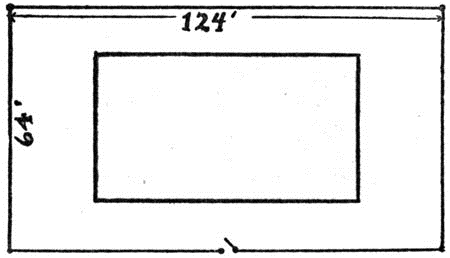
Where the court is entirely enclosed by the stop-nets the over-all dimensions may well be those given, but they should not be smaller than 60 × 120 ft.
While the usual backstop is made of hollow iron posts sunk in the ground at intervals of 10 or 15 feet, with chicken or fence wire stretched taut between them, it is not unusual to-day to find more elaborate affairs of genuine architectural worth to harmonize with the residence and other buildings. Pergola effects are thus used. The posts of solid wood are sunk in the ground, and then wrapped with wire netting to hold the stucco. The latter is applied in the usual way and finished off in white, cream-white, or gray. The wire net must be stretched from post to post before the stucco is applied. Wooden beams join the tops of the stucco columns, and a foot molding, with sometimes a railing, connects the posts from base to base. The rather elaborate character of such tennis backstops cannot always be worked out by a novice, although a good carpenter or mason can do the work if the plans are sketched carefully in advance.
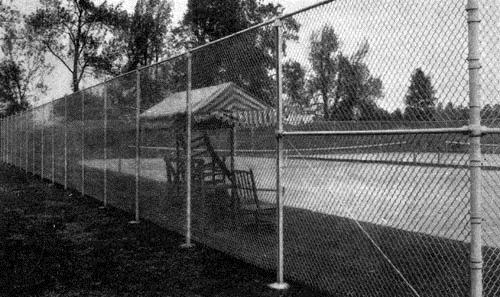
The simplest form of backstop is the frame of iron pipe forms, which are now made especially for that purpose, covered with the ordinary wire netting
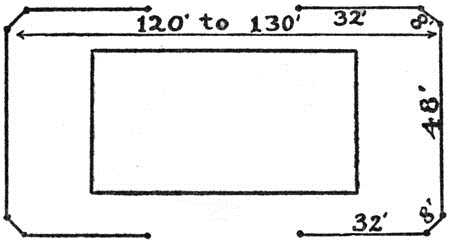
A saving of stop-nets is frequently made by leaving open spaces at the sides
The plain backstop of wire net and iron posts does not enhance the beauty of the lawn, and consequently many experiments have been made to eliminate, so far as possible, their ugly appearance. Painting the whole affair a grass green so as to render it as inconspicuous as possible, is one way of partly achieving the desired results. Another simple and more satisfactory method of hiding the plain backstops is to utilize the things which nature furnishes so lavishly for us. These may be growing in our garden or found rampant in the fields and woods, climbing over hedges and fences and reaching to the tops of trees.
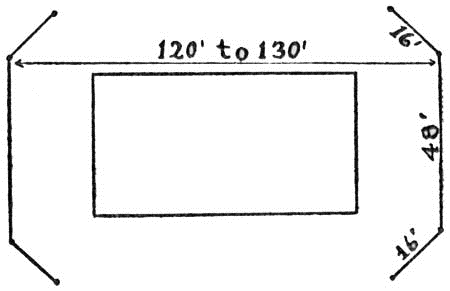
The most economical form of stop-net is here shown, although it will not, of course, stop all stray balls
For instance the wire net erected at either end back of the courts can be converted into screens of living green by planting vines on the outside, or, if one prefers, it can be covered with the climbing roses to make it a glorious color effect. Better even than the ordinary wire net, an artistic screen of lattice work or trellis can be erected. This can be covered on the back with almost any of the climbing vines. Roses, honeysuckle, clematis, trumpet vine, or moon flower are all suitable for this purpose. With a little pruning and training, the screen can, within a season or two, be converted into a beautiful garden ornament.
A grass tennis court with back nets to keep the balls from going too far, covered with climbing vines or flowers, adds so much to the appearance of a garden that other improvements are sure to follow. A series of rustic benches for spectators should be arranged on the west side, so that they can watch the afternoon game without having the sun in their eyes. If the land is rolling and hilly, the benches should be placed on a terrace at one side.
A tea house of suitable character is a great addition to a tennis court. This may be nothing more than a rustic covering to protect the heads of the spectators, with seats and a rustic table for serving the tea. If it is built on a terrace on the west side of the court visitors can watch the game under the most comfortable circumstances.
Nets of a great variety, from plain, machine-made twine to the hand-made, double-knitted cotton ones, canvas-bound at top and bottom, and reinforced at the corners and middle, may be had to-day. A strong, durable net is the cheapest in the end, and there will be less trouble from shrinking and stretching. For single courts the nets are 27 feet long and 3 feet high, and for double courts they run from 36 to 42 feet in length.
The most serviceable posts for holding the nets in position are those made with anchor sockets, which are permanently driven in the ground. These spade-shaped iron sockets hold the posts firmly in an upright position without the use of guy ropes. When the posts are removed from the sockets a wooden plug is inserted to keep dirt from collecting in them. In addition to this the iron posts are supplied with tennis-net reels that tighten or loosen the net as demanded. The reels automatically lock to hold the net firmly in position, and they are instantly released by moving the handle.
Other varieties of tennis posts can be used if needed, but the wooden poles supported by guy ropes and pegs are the least satisfactory. The pegs are constantly pulling out and destroying the sod. Straight iron anchor posts are better than these. They are driven in the ground, and by means of triple claw clutches they are held rigid. In place of the iron center forks for holding the middle of the net at the regulation three-foot height, canvas center straps are now preferred. The canvas straps do not chafe the net, and cannot cause the ball to glance off and strike out of court. Another method sometimes used for holding the top line of the net straight is to use galvanized steel cable top cords. These cords are a quarter of an inch thick, with metal loops at the ends and manila rope ends to fasten to the posts. They keep the net from sagging in the middle. Canvas-bound nets are also designed to keep the top firm.
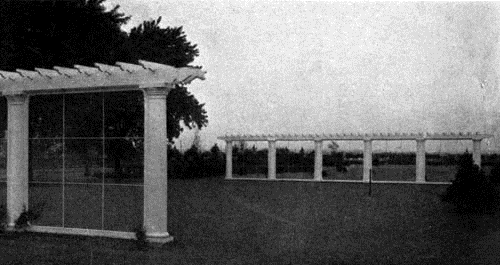
It is strange that more people do not make the backstops a real architectural feature as for this court on Mr. Gage E. Tarbell's estate, Nassau Boulevard, L.I., Oswald C. Hering, architect
CARE OF COURTS
A WELL made court, whether of clay or turf, is an achievement to be proud of, and it will give more satisfaction than any other one thing; but it is essential that it should be kept in prime condition all the time. Constant watchfulness and attention are the price we pay for the proper maintenance of a first-class tennis court. The clay court will degenerate as rapidly as a macadam road, without proper repairs, and the turf court will lose its beauty and usefulness much faster than a green lawn if not attended to. A little intelligent care given to the court each week will preserve it from utter ruin, which must inevitably result if damages are not repaired at once.
The clay or dirt court must be gone over about every second day to fill in and roll down depressions made by the feet of the players. On courts where playing is almost continuous, the rule is to make repairs every day or after every ten sets have been played on them. The simplest and most effective way to keep a clay court in repair is to take a straight log or thick piece of wood, five to eight feet in length, and nail to it coarse bagging or jute cloth. If the edges are frayed out, so much the better. Attach ropes to either end of this log, and drag it across the court several times. The ragged edges of the cloth will smooth out the surface and work the dirt into holes or depressions. If hard ridges or lumps still exist these must be loosened by hand or a hoe.
After the drag has smoothed out the surface, it should be watered, in dry weather, and then rolled. A good hand roller is almost essential to the preservation of the court. The operator should always walk in front of the roller and not behind it. The rolling should continue until the surface is rendered entirely smooth. After the rolling the wet surface should be allowed to dry before the courts are marked out again.
The care of the grass court must depend a good deal upon how much it is used and the condition of the weather. In very wet seasons, the turf is soft and spongy, and the heels of the players cut deeper into it. This produces slight depressions that may in time increase, so as to ruin the surface if not attended to at once. On the other hand, in very dry weather, the grass is more easily scoured and killed, and there must be frequent wetting to keep the turf in good condition.
The grass courts should always be watered at night after the play. Any time after the last game will do, although about sun-down is a good time. Cutting should be done early in the morning after the watering, and then the roller should be applied. This puts the court in fine condition for playing. If the grass is cut in the morning without previous watering at night, it may be injured by the hot sun, especially if the heavy roller is applied. The simple rule is: water at night, cut in the morning, and then roll.
All bare strips of grass should be replaced as soon as possible with fresh sod. Cut out the old sod evenly and put down good new sod with edges fitting snugly. Sometimes new seed sown occasionally will answer the purpose, but not in the spots where the feet of the players work the greatest damage. If many deep depressions have been made by the feet of the players in wet weather, they should be filled in with more dirt and fresh sod planted and tamped down firmly.
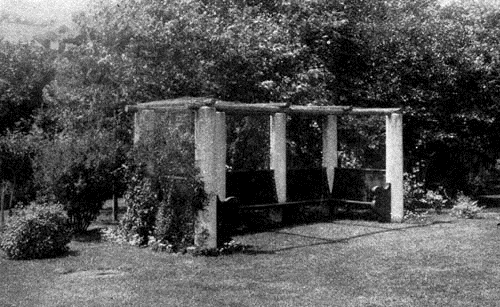
There is opportunity at the side of the court for some feature in the way of a shelter or seats for the spectators
Every spring the grass court needs special attention. In March or February all extensive repairs should be made to the damaged turf. New sod should be put down wherever the grass is poor or worn, and if fitted snugly in place, new seed sown, and a good top-dressing of manure supplied, the court should be in fine condition by playing time. Of course regular manuring should be done in the fall of the year, the same as for the lawn, and in the spring it should be raked off and the surface rolled. Before rolling, however, the grass should be swept. Sweeping is much better than raking even through the summer season, for the tines of the rake are apt to dig up the grass roots.
Sweeping is also good for worm casts, which spoil a good many courts. The broom scatters the little mounds caused by the worms, and then the roller smooths the surface so that no irregularities are apparent. Some sprinkle lime water over the places where the worms are numerous, and as this brings them squirming to the surface they are swept away and destroyed.
It goes without saying that all tennis players should be required to wear rubber-soled shoes without heels. The damage to the court from shoes with heels is sometimes so great when the turf is soft that it will take half a season to repair it. Where tennis courts are a part of the general lawn a horse machine may be used for cutting the grass. In such cases the hoofs of the horses should be padded to prevent leaving sharp imprints in the turf.
If these directions for keeping a tennis court in good condition are faithfully followed there is no reason why a first-class court cannot be maintained indefinitely at little expense. It may be, in addition to this care, that a little work in exterminating weeds will be called for through the growing season. Obnoxious weeds must never be allowed to spread and get a foothold, or they will crowd out and kill the finer grass. They must be pulled or dug up by the roots as fast as they appear, and never be allowed to go to seed.


